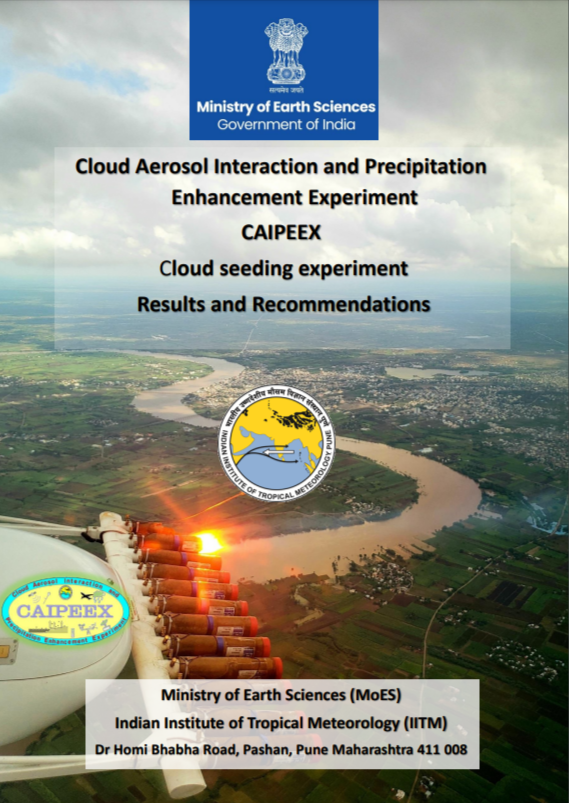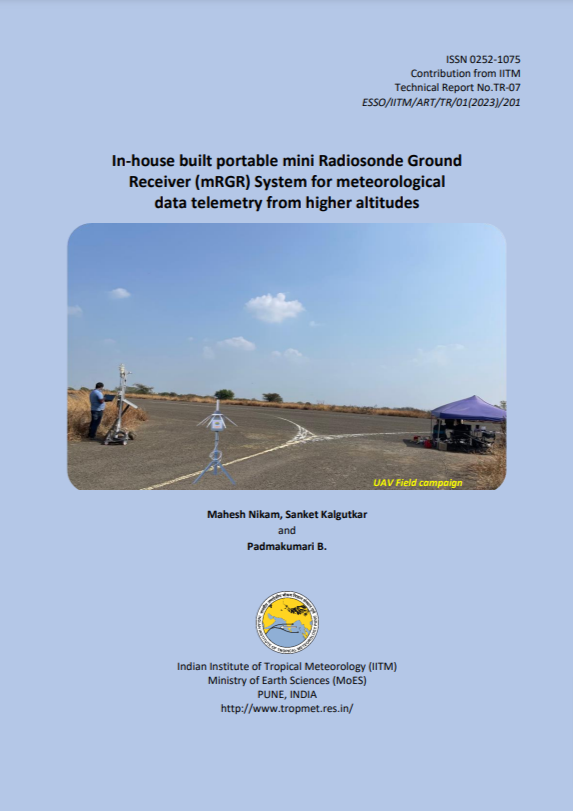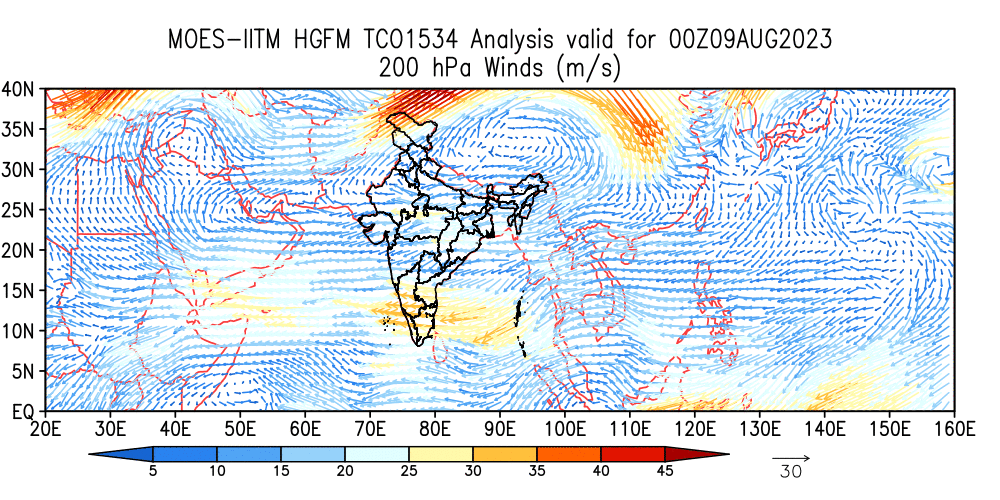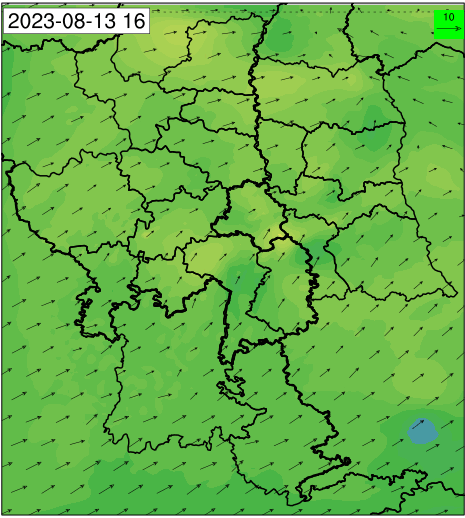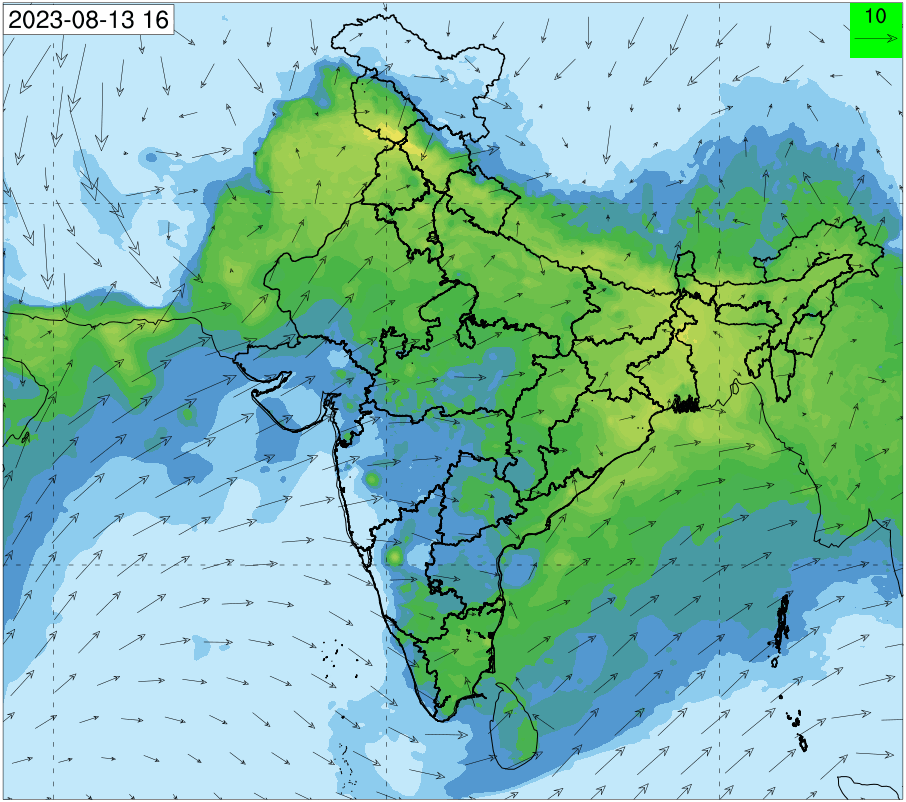Seminars / Lectures
IITM Publication Highlights
CAIPEEX - Indian cloud seeding scientific experiment
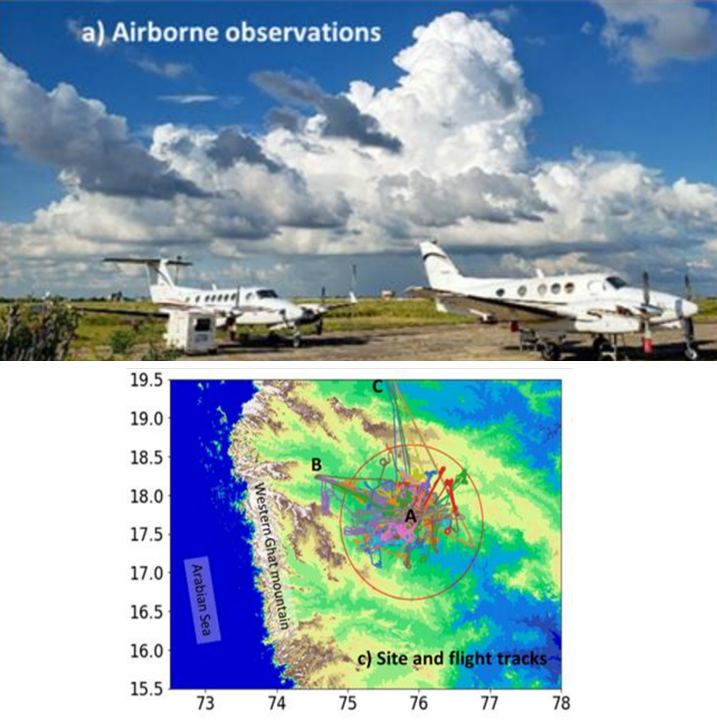 In the fourth phase of the Cloud Aerosol Interaction and Precipitation Enhancement Experiment (CAIPEEX-IV), a scientific investigation was conducted over a rain shadow region of the Western Ghats mountains in India. The primary objective was to investigate the efficacy of hygroscopic seeding in convective clouds and to develop a cloud seeding protocol. The initial results of the campaign in the monsoon period of 2018 and 2019 with two instrumented aircraft, a ground-based dual-polarization C-band radar, a network of rain gauges, radiosondes, and surface aerosol measurements are reported here. The hygroscopic seeding material was detected in cloud droplets and key cloud microphysical processes in the seeding hypothesis were tracked. The experimental results suggest that cloud seeding can be approached scientifically to reduce uncertainty. The results from this study should interest the scientific community and policymakers concerned with climate change’s impact on precipitation and how to mitigate rainfall deficiencies.
In the fourth phase of the Cloud Aerosol Interaction and Precipitation Enhancement Experiment (CAIPEEX-IV), a scientific investigation was conducted over a rain shadow region of the Western Ghats mountains in India. The primary objective was to investigate the efficacy of hygroscopic seeding in convective clouds and to develop a cloud seeding protocol. The initial results of the campaign in the monsoon period of 2018 and 2019 with two instrumented aircraft, a ground-based dual-polarization C-band radar, a network of rain gauges, radiosondes, and surface aerosol measurements are reported here. The hygroscopic seeding material was detected in cloud droplets and key cloud microphysical processes in the seeding hypothesis were tracked. The experimental results suggest that cloud seeding can be approached scientifically to reduce uncertainty. The results from this study should interest the scientific community and policymakers concerned with climate change’s impact on precipitation and how to mitigate rainfall deficiencies.
Prabhakaran Thara, Murugavel P., Konwar M., Malap N., Gayatri K., Dixit S., Samanta S., Chowdhuri S., Bera S., Varghese M., Jaya Rao Y., Sandeep J., Safai P.D., Sahai A.K., Axisa D., Karipot A., Baumgardner D., Werden B., Fortner E., Hibert K., Nair S., Bankar S., Gurnule D., Todekar K., Jose J., Jayachandran V., Soyam P.S., Gupta A., Choudhary H., Aravindhavel A., Kantipudi S.B., Pradeepkumar P., Krishnan R., Nandakumar K., DeCarlo P.F., Worsnop D., Bhat G.S., Rajeevan M., Nanjundiah R., Bulletin of the American Meteorological Society, Online, October 2023, DOI:10.1175/BAMS-D-21-0291.1
Read MoreAir pollution reductions caused by the COVID-19 lockdown open up a way to preserve the Himalayan glaciers
 The influence of the spring 2020 COVID-19 lockdown on the HKH have been assessed, demonstrating
the potential benefits of a strict emission reduction roadmap. Chemistry–climate model
simulations, supported by satellite and ground measurements, show that lower levels of gas and
aerosol pollution during lockdown led to changes in meteorology and to a reduction in black carbon
in snow (2 %–14 %) and thus a reduction in snowmelt (10 %–40 %). This caused increases
in snow cover (6 %–12 %) and mass (2 %–20 %) and a decrease in runoff (5 %–55 %)
over the HKH and Tibetan Plateau, ultimately leading to enhanced snow-equivalent water (2
%–55 %). The study emphasizes the necessity for immediate anthropogenic pollution reductions
to address the hydro-climatic threat to billions of people in southern Asia.
The influence of the spring 2020 COVID-19 lockdown on the HKH have been assessed, demonstrating
the potential benefits of a strict emission reduction roadmap. Chemistry–climate model
simulations, supported by satellite and ground measurements, show that lower levels of gas and
aerosol pollution during lockdown led to changes in meteorology and to a reduction in black carbon
in snow (2 %–14 %) and thus a reduction in snowmelt (10 %–40 %). This caused increases
in snow cover (6 %–12 %) and mass (2 %–20 %) and a decrease in runoff (5 %–55 %)
over the HKH and Tibetan Plateau, ultimately leading to enhanced snow-equivalent water (2
%–55 %). The study emphasizes the necessity for immediate anthropogenic pollution reductions
to address the hydro-climatic threat to billions of people in southern Asia.
Fadnavis S., Heinold B., Sabin T.P., Kubin A., Huang K., Rap A., Müller R., Atmospheric Chemistry and Physics, 23, September 2023, DOI:10.5194/acp-23-10439-2023, 10439-10449
Read MoreEvaluation of the Global Ensemble Forecast System (GEFS T1534) for the probabilistic prediction of cyclonic disturbances over the North Indian Ocean during 2020 and 2021
 The study evaluates the skill of prediction of genesis as well as the verification of CDs
(total of 16 cases are considered) that occurred during the year 2020–2021, using Global
Ensemble Forecast System (GEFS) T1534. Different initial conditions with longer lead hours are
analysed for genesis, track, intensity and landfall errors. The model has the ability to predict
genesis location with error of about ~200 km at day 2 lead. Verification of all CDs indicates that
the landfall in terms of time and position is well predicted by the model. In general, the model
shows the northward bias in genesis location error for the initial 12 hours and after that
southwestward bias. From depression till dissipation, the track error for ensemble mean is less
than that of the control run. The track error is less than 150 km for ensemble mean till day 3 and
is about 220 km on day 4. The model shows northward bias in predicting the track of CDs. For
predicting the landfall locations, southwestward bias is shown by model. The probabilistic ensemble
skill scores are also evaluated for GEFS T1534, which shows reasonable skill.
The study evaluates the skill of prediction of genesis as well as the verification of CDs
(total of 16 cases are considered) that occurred during the year 2020–2021, using Global
Ensemble Forecast System (GEFS) T1534. Different initial conditions with longer lead hours are
analysed for genesis, track, intensity and landfall errors. The model has the ability to predict
genesis location with error of about ~200 km at day 2 lead. Verification of all CDs indicates that
the landfall in terms of time and position is well predicted by the model. In general, the model
shows the northward bias in genesis location error for the initial 12 hours and after that
southwestward bias. From depression till dissipation, the track error for ensemble mean is less
than that of the control run. The track error is less than 150 km for ensemble mean till day 3 and
is about 220 km on day 4. The model shows northward bias in predicting the track of CDs. For
predicting the landfall locations, southwestward bias is shown by model. The probabilistic ensemble
skill scores are also evaluated for GEFS T1534, which shows reasonable skill.
Kanase R., Tirkey S., Deshpande M., Phani M.K.R., Johny C.J., Mukhopadhyay P., Iyengar G., Mohapatra M., Journal of Earth System Science, 132: 143, August 2023, DOI:10.1007/s12040-023-02166-2, 1-14
Read MoreThermodynamical framework for effective mitigation of high aerosol loading in the Indo‑Gangetic Plain during winter
 This study presents a thermodynamically consistent "roadmap" for effective aerosol mitigation
in the Indo-Gangetic Plain (IGP). The proposed framework categorically considers aerosol acidity
(pH) and aerosol liquid water content (ALWC) as the governing parameters that modulate the mass
loading of aerosols. The thermodynamic control suggests that HCl and HNO3 reductions
would be the most effective pathway to reduce aerosol loading over IGP. Following the framework
advanced in this study, India may develop its own and more precise solution to its severe air
pollution problem during winter.
This study presents a thermodynamically consistent "roadmap" for effective aerosol mitigation
in the Indo-Gangetic Plain (IGP). The proposed framework categorically considers aerosol acidity
(pH) and aerosol liquid water content (ALWC) as the governing parameters that modulate the mass
loading of aerosols. The thermodynamic control suggests that HCl and HNO3 reductions
would be the most effective pathway to reduce aerosol loading over IGP. Following the framework
advanced in this study, India may develop its own and more precise solution to its severe air
pollution problem during winter.
Acharja P., Ghude S.D., Sinha B., Barth M., Govardhan G., Kulkarni R., Sinha V., Kumar Rajesh, Ali K., Gultepe I., Petit J.-E., Rajeevan M.N., Scientific Reports, 13: 13667, August 2023, DOI:10.1038/s41598-023-40657-w, 1-10
Read MoreMicrophysical characteristics of cyclonic rainfall: A GPM-DPR based study over the Arabian Sea
 The rainfall characteristics associated with the tropical cyclone, formed over the Arabian Sea during the onset phase of the Indian summer monsoon and in the post-monsoon seasons, were investigated during the period from 2014 to 2021 using the Global Precipitation Measurement-Dual-frequency Precipitation Radar (GPM-DPR).Tropical cyclone formed during the monsoon onset phase was found to be characterized with high fraction of intense rain rate, strong reflectivity and bigger Raindrops. The contribution of collision-coalescence is significantly high in convective rain whereas the break-up process is found to be dominant in the stratiform rain.
The rainfall characteristics associated with the tropical cyclone, formed over the Arabian Sea during the onset phase of the Indian summer monsoon and in the post-monsoon seasons, were investigated during the period from 2014 to 2021 using the Global Precipitation Measurement-Dual-frequency Precipitation Radar (GPM-DPR).Tropical cyclone formed during the monsoon onset phase was found to be characterized with high fraction of intense rain rate, strong reflectivity and bigger Raindrops. The contribution of collision-coalescence is significantly high in convective rain whereas the break-up process is found to be dominant in the stratiform rain.
Kumar Amit, Srivastava Atul K., Sunilkumar K., Srivastava M.K., Earth and Space Science, 10: e2023EA002895, October 2023, DOI:10.1029/2023EA002895, 1-14
Read MoreNew Publications
Eddy dissipation rates in the dryline boundary layer
Solanki R., Jaya Rao Y., Malap N., Prasad P., Prabhakaran Thara, Environmental Fluid Mechanics, Online, October 2023, DOI:10.1007/s10652-023-09954-w, 1-14
North Indian Ocean sea level rise in the past and future: The role of climate change and variability
Jyoti J., Swapna P., Krishnan R., Global and Planetary Change, 228: 104205, September 2023, DOI:10.1016/j.gloplacha.2023.104205, 1-13
The DC and AC global electric circuits and climate
Siingh D., Singh R.P., Victor N. J., Kamra A.K., Earth Science Reviews, 244:104542, September 2023, DOI:10.1016/j.earscirev.2023.104542, 1-28
Improving the subseasonal variability of the Indian summer monsoon in a climate model
Srivastava Ankur, Rao Suryachandra A., Ghosh S., International Journal of Climatology, 43, September 2023 DOI:10.1002/joc.8142, 5227-5247
PDF Publisher LinkIITM Events

IITM Foundation Day 2023
(17 November 2023)
IITM celebrated its 62nd Foundation Day on 17th November 2023. Shri Nilesh M. Desai, Director, SAC, Ahmedabad was the Chief Guest and Prof. Janardhan Padmanabhan, INSA Senior Scientist, PRL, Ahmedabad and Prof. Trenton Franz, Associate Professor, University of Nebraska, Lincoln, USA were the Guests of Honor on this occasion.

Visit of Hon’ble Minister of Earth Sciences to HACPL
(05 October 2023)
The Hon’ble Cabinet Minister of Earth Sciences, Govt. of India, Shri Kiren Rijiju visited High Altitude Cloud Physics Laboratory (HACPL) at Mahabaleshwar on 5 October 2023 to review the ongoing observational research activities at the lab.

ICRC-CORDEX 2023 Conference
(25-29 September 2023)
IITM Hub of International Conference on Regional Climate – Coordinated Regional Climate Downscaling Experiment 2023 (ICRC-CORDEX 2023) was successfully organized in a hybrid mode, at Indian Institute of Tropical Meteorology, Pune & Trieste, Italy, during 25-29 September 2023.

